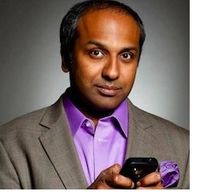One of the most popular forms of content creation today is interviews … but great interviews take a lot more than just coming up with a list of questions. The sad fact is, not everyone who creates interviews to post online is actually good at doing them. So you might wonder, what do the people who ARE really good at it already know?
Over the last month I've done over 30 interviews as part of launching Likeonomics (that's more than one a day). Across that time, I've done everything from answering emailed questions to sitting in a broadcast TV studio. Apart from getting good at sharing soundbites, the last month has really given me an up close look at almost every style of interviewing you can imagine.
Through that time, there were a few interviews that really stood out – and five in particular which I have singled out and included in this article. Together they offer some valuable lessons for anyone who needs to produce and publish any kind of interview.

Anna Farmery was an early influencer to get the book, and her Engaging Brand Podcast was one of the first interviews I did for the book. Within 30 seconds of starting the interview, it was clear that she had really read the book and thought about it (you would be amazed at how many interviewers don't). Her questions were fair, insightful and challenging in the right places. Having her among the first helped prepare me for several of the interviews and questions I would get later during my media push for the book. And the interview experience remains one of my favourites – all because she took the time to prepare like a pro.
2. Invent your own style. (From: Laura Fitton – aka "@pistachio")


When Katya Andreson decided to feature Likeonomics on her very popular nonprofit marketing blog, she asked me to respond to a very pointed question about how nonprofits could use the ideas in Likeonomics. I shared two responses for truths that nonprofits should share and she used both in her blog post. It would have been easy to stop there – but she didn't. Instead, she added her own take, a few lines of commentary and then a link to a wonderful video to demonstrate the points we both had made in the post. That additional effort made the piece her own, and engaged her fans – all because she took the high road to add value to an interview instead of taking the lazier "cut and paste" route.
4. Dig deeper to get the full picture. (From: David Siteman Garland)

5. Work with the tools you have. (From: Sree Sreenivasan)

Do you produce your own content or have you had an interview with someone that really stood out? Share your own tips about what makes a great interview or interviewer in a comment on this post!






WE RECENTLY REMOVED COMMENTING - LEARN WHY HERE >